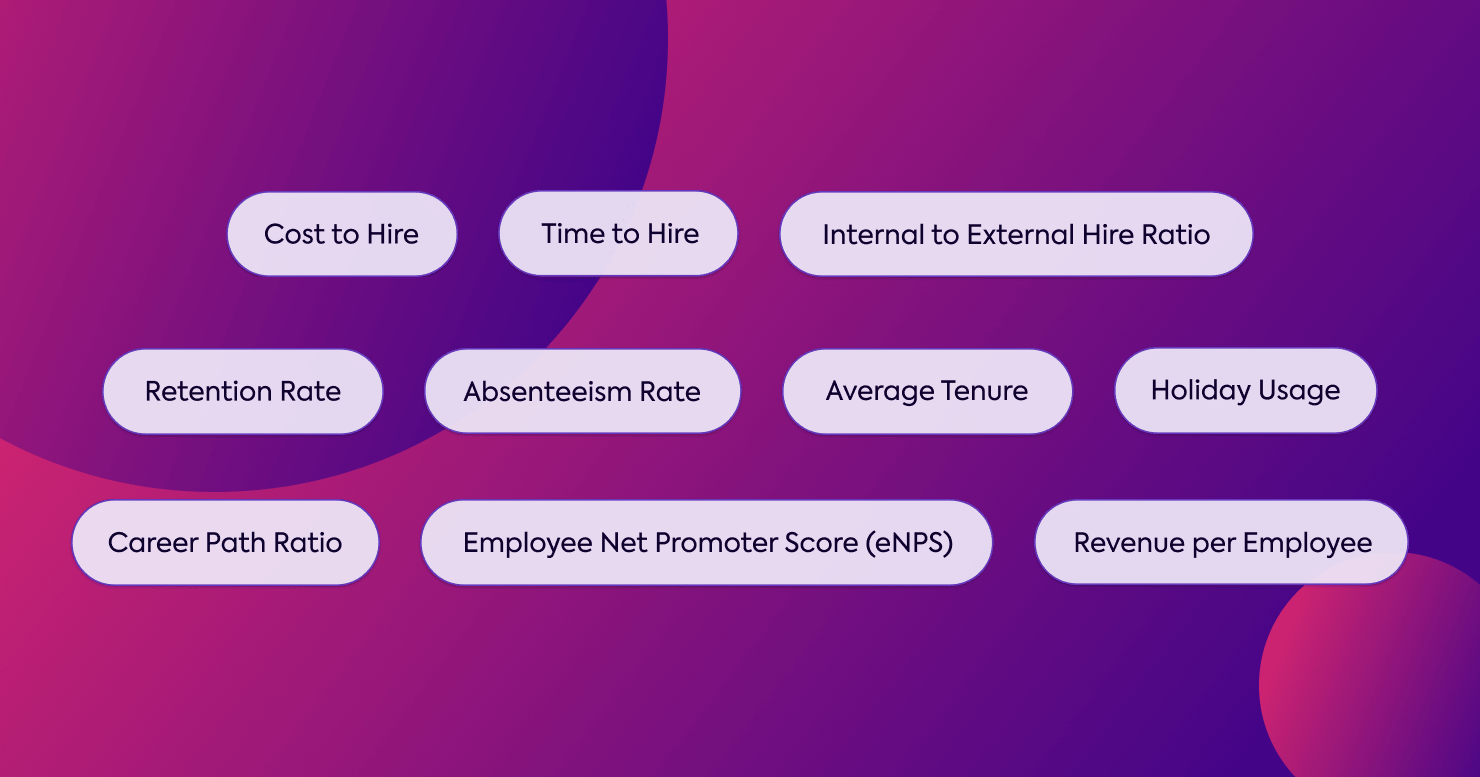The key to driving results is understanding your HR KPIs. Learn about the most important HR KPIs for your reporting dashboard.
There’s a growing recognition that, often, a company’s most important assets are its people. Without people – and talented, happy, motivated people at that – you will never execute your company strategy and achieve your goals.
HR or Human Resources KPIs are critical as not only do they help to measure the success of the department and employee satisfaction, but they establish and maintain effective practices throughout the entire organisation.
Therefore, the Human Resources department of any business is progressively important. Senior HR leaders – be they HR Directors or Chief People Officers – increasingly sit on Boards and Leadership teams and are accountable for the types of KPIs we’ll outline in this article. There are many important KPIs that a good HR leader would track as part of their strategic planning.
Here we’ll look at:
- Recruitment KPIs
- Employee KPIs
- Learning & Development KPIs
- Culture KPIs
- Equality KPIs
- Performance KPIs
- Compensation KPIs
Example Recruitment KPIs
Recruitment is a large part of any HR strategy, ensuring there’s a good talent pipeline with new ideas, skills and energy coming into the business. Let’s take a look at some KPIs that are used to evaluate recruitment within HR…
Cost to Hire
Type: Currency
The cost per hire is a key factor when anyone is considering recruiting talent. There are a wide range of potential channels for recruitment, from internal referrals through to specialist job boards and social networks. Cost to Hire is a KPI that is always considered when mapping out the budget for the year ahead.
Time To Hire
Type: Duration
This KPI measures the time it takes to hire new talent into the business. It’s important because it directly impacts your overall planning. For example, if you need a new designer in the business and it takes an average of 3 months to hire, then you should begin to advertise well in advance of the requirement. Time to Hire is measured by the number of days between the job being agreed and the candidate starting the role.
Candidate Skill Match
Type: Percentage
A good job description is key to attracting skilled candidates. This KPI looks at what percentage of the overall applications were candidates who had the skills required for the job criteria. You’ll always get applications from candidates who are not experienced or skilled in the right areas, but this KPI is none the less a good indicator of an effective job advert.
Job Offer Acceptance Rate
Type: Percentage
This KPI looks at what percentage of the offers made to candidates are ultimately accepted. If this metric is low it can suggest a problem with your package, benefits or overall company culture. It’s useful to always get feedback if candidates turn you down.
Application Drop-Out Rate / Withdrawal Rate
Type: Percentage
Most applications will include a certain level of drop-out at every stage of the process. You might have an application form that is too long, or you may not hear back from interview offers, or perhaps at the last minute the candidate has a counter job offer. The drop-out or withdrawal rate is a measurement of that process and a KPI used to determine if you require your recruitment process funnel to be improved.
Internal to External Hire Ratio
Type: Percentage
Hiring internally is great as it promotes employee career development, ensures retention, and reduces cost to hire. Equally, hiring externally is important as it brings in new skills and development, produces new ideas and reduces risk of key talent turnover. With both internal and external being great sources, measuring this KPI ensures you are getting the balance right in your hiring.
Candidate Satisfaction Score
Type: Percentage
This KPI is calculated by asking candidates how they found the process of recruitment. It’s often reserved for successful candidates and used to gather feedback to improve the overall experience.
Year 1 Turnover Rate
Type: Percentage
If an employee leaves within the first year there can often be a sign of issues, even if it isn’t the employee’s choice to depart. This KPI looks at the percentage of workforce who depart the business within the first year and, if high, raises questions about the recruitment and onboarding process.
Example Employee KPIs
Employee KPIs look at areas such as retention and development. Here are some examples…
Retention Rate
Type: Percentage
A really important metric for any HR department! Retention Rate looks at the percentage of employees who have remained with the company, often measured within the last 12 months. It’s healthy to have some turnover, but overall a high retention is a good thing for a business.
Key Talent Retention Rate
Type: Percentage
If you’re a business who lists their top talent and individuals you want to keep, then having a specific Retention Rate on these employees can be very helpful. It’s represented as a percentage of the key talent who are still with the business.
Absenteeism Rate
Type: Percentage or Duration
Looking at an Absentee Rate for an employee can be a flag that a discussion is required. It might be the employee requires help or has circumstances in their life that you need to know about as part of your duty of care or may be a sign that they are not that engaged and are demotivated. This KPI is measured by number of days or percentage of total working days absent.
Average Absenteeism Rate
Type: Percentage or Duration
Similar to the above, this KPI looks at the average rate across the whole team. If this is high then it’s a clear indicator of problems. Like the individual rates, this is often measured as number of days or the percentage of time absent.
Absence Cost
Type: Currency
This KPI measures the cost to the company of employees being absent. The calculation includes the cost of the employee and any replacement costs.
Average Tenure
Type: Duration
This KPI is used to measure the average length of time an employee stays with the company. It’s a useful measurement of satisfaction and engagement.
Turnover Rate or Attrition Rate
Type: Percentage
Turnover Rate is the percentage of staff that have left, often measured within the context of a financial year or last 12 months. A high turnover can be costly due to the additional hiring required, onboarding costs, and loss of overall knowledge and skills within the business.
Voluntary Turnover Rate
Type: Percentage
While Turnover Rate measures total turnover, Voluntary Turnover Rate splits out the measurement to look at the employees who choose to leave the business. It’s important to split this out from the general turnover rate if you’re looking to improve it.
Involuntary Turnover Rate
Type: Percentage
As you’d expect, this KPI looks at those who did not choose to leave the business. If you’re looking at a high Turnover Rate it’s key to understand if the departures were chosen or forced, as your action to reduce the rate would be different for each.
Retirement Rate
Type: Percentage
This KPI looks at the number of employees who have retired. Unlike other turnover metrics, which often look backwards, the Retirement Rate KPI is more predictable for the future and thus can be used within your strategic planning.
Number of Employees
Type: Number
A simple KPI measuring the number of employees that are within a business.
Part Time Employees
Type: Percentage or Number
This KPI is used to understand how many employees are part time workers. It can be seen as a percentage of overall workforce or the actual number, and is used to understand how the trend of work is changing over time. This in turn impacts your planning around office space and throughput.
Number of Contractors
Type: Percentage of Number
This metric is looking at either the percentage of the team who are contractors or the number of contractors in the business. Contractors are expensive and can have a high turnover rate, so keeping an eye on the number is important for many businesses.
Example Learning & Development KPIs
Ongoing learning and development is key to help move your company forward, so here are some KPIs to track your progress.
Training Cost Per Employee
Type: Currency
Measuring the average spend per employee on L&D activity is important to ensure you’re investing in your talent, developing your people, and moving the business forward. This metric provides an average cost spent per employee, so will provide insight into your spending and how fairly spread development is across the business.
Time Per Employee
Type: Duration
Certain businesses provide employees with set time to focus on learning, development or innovation. In these companies it’s wise to measure the time spent as a KPI to ensure you’re meeting your objectives.
L&D Satisfaction
Type: Percentage
This KPI is similar to NPS (Net Promoter Score) and directly measures how employees feel about their learning and development work. It can be used to understand how effective training is within a role or how the developmental needs of an employee are being met.
Percentage of Team Trained
Type: Percentage
It’s important to ensure the whole team are developed within your business. This KPI looks at the percentage of the employees who have been through training programs. It’s sometimes used as an aggregate measure at a top level, other times it can be a number of specific KPIs relating to individual training.
Example Culture KPIs
Culture is such an important part of growing your business. Fostering a culture that stimulates innovation, motivation and engagement are key as you drive your strategic growth. So what are some of the KPIs that link to Culture? Let’s take a look…
Employee Net Promoter Score (eNPS)
Type: Number of Percentage
This KPI is a version of Net Promoter Score for your employees. Like with your customer NPS, this is a way to measure how satisfied your people are working in the business. It works by asking a single question:
How likely is it that you would recommend working for this company?
The employee responds by answering between 0 – 10.
Employees who respond 9 and 10 are Promoters
Employees who respond 7 or 8 are considered Passive
Employees who respond 0 – 6 are Detractors
The NPS Score is measured by taking the Number of Promoters – Number of Detractors. A low NPS can result in a high employee turnover.
New Employees
Type: Number of Percentage
This KPI looks at either the number of new joiners or the percentage of workforce that is new. It’s important to measure in the context of culture as too many new joiners entering the business at once will potentially alter your culture and needs management. A high number for this KPI will also flag areas around onboarding and company performance that may need to be monitored.
Holiday Usage
Type: Percentage
Taking time off is important for employee mental health and wellbeing, so this more recent KPI looks at what the average percentage of holiday taken across the business.
Operational Suggestions
Type: Number
Stimulating ideas from the team can be a great way to improve your company. It might be new product or service concepts, process improvements, or ideas around CSR. Whatever they are, an open culture that encourages ideas is a good environment for employees. This KPI measures the number of suggestions coming from the team on an annual basis.
Internal Job Hires
Type: Percentage
A good culture fosters individual growth and development, so looking at the percentage of roles that are filled by internal candidates can be a good way to measure overall progression of the team.
Career Path Ratio
Type: Percentage
This KPI is used to track the number of people moving within the organisation, in a similar way to Internal Job Hires does above. It’s the ratio of promotions to transfers. To calculate the ratio you would follow this equation:
Number of Promotions ÷ (Number of Promotions + Number of Transfers)
For example, if you have had 10 promotions in a year and 25 other transfers, your calculation would be: 10 ÷ (10 + 25). Your Career Path Ratio would therefore be 28%.
This metric will help you understand how many employees are advancing in their career and those moving role within your company.
Cultural Training
Type: Percentage
Culture is such an important part of any company that it often has some form of introduction or training as part of onboarding. In times of change or high levels of new joiners, you might use this KPI to measure number of employees who have been trained.
Example Equality KPIs
Fairness and equality are key in any HR strategy, here are some examples of the KPIs you may measure…
Female to Male Ratio
Type: Percentage
An important part of a successful company is equal representation at all levels. This ratio of female to male can be applied at Board, Management, or all employees, and is often tracked as part of a target to be equal in split.
Diversity
Type: Multiple
Diversity features in many company strategic plans. It promotes innovation and ideas, helps to form a cohesive company, and provides opportunity to all parts of society. The way diversity as a KPI is measured ranges, sometimes looking at the largest pool not being greater than x% of the workforce or management team, other times looking at what % is composed of certain demographics. There’s no single KPI for Diversity, in fact it could be a whole article, but we’ll add it here to ensure that you measure it in some capacity.
Pay Gap Ratio
Type: Percentage
This KPI will help you identify if you have any pay gaps within your organization. Pay gaps between different demographics of employees are red flags that unfairness, and even discrimination, exists in the company. Pay gaps are unfair, potentially unlawful, and are not conducive to an inclusive, happy working culture.
Whether you are monitoring your pay gap ratio based on gender, ethnicity or any other demographical variant, the calculation to follow is:
(Avg. pay category A) – (avg. pay category B) / (avg. pay category A) x 100
You could track your pay gap ratio across the whole organization, or, more usefully compare the average salaries or wages for different, say, genders if looking at your gender pay gap, in the same function. That way you are comparing like for like, where, all being right, there should be no pay gap based on identity-related differences.
Example Performance KPIs
Measuring performance of employees may be part of your HR Dashboard. Here are some example KPIs in this area…
Revenue per Employee
Type: Currency
Revenue per Employee is a financial KPI often used to compare companies. It represents the amount of revenue generated per employee and is sometimes seen as a way to show how successful a business is at using their resources. It’s calculated by Revenue ÷ Number of Employees and is also known as Revenue per FTE (Full Time Employee). This KPI is also featured in our Complete List of Financial KPIs.
Performance Management Ratio
Type: Percentage
This KPI looks at the percentage of employees currently on performance management or with performance concerns.
HR to FTE Ratio
Type: Percentage
As a company goes your HR function will need to expand, this KPI keeps track of the ratio between number of full time employees and HR team members. It can be used to understand how effective the function is and be one consideration when looking to expand.
Workforce Cost
Type: Currency or Percentage
This KPI looks at the total cost of employees in the organisation. It can be used either as a financial figure or as a percentage of total costs.
Example Compensation KPIs
Understanding how you compensate your workforce will enable you to maintain good retention and satisfaction.
Salary Competitive Ratio
Type: Percentage
This KPI measures how the salaries you offer compare to average benchmarks or competitors. It can be used at a company level, averaging out the number, or at individual job levels. To calculate this ratio you use the formula:
Salary Competitive Ratio = Salary Offered ÷ Benchmark Salary
The Benchmark Salary may come from industry sources or specific competitors. For example, if you pay £50,000 and your competitors pay £60,000 your Salary Competitive Ratio would be 83%.
Benefit Satisfaction Ratio
Type: Percentage
This metric measures how satisfied your employees are with the benefits package. The format can be similar to NPS and is a way to measure if your benefits are contributing to a good retention and overall satisfaction.
So there are some common and important metrics relating to people. As always, we would recommend choosing the KPIs from this list that make the most sense for your business to ensure you have a focused HR reporting dashboard. Too many KPIs can lead to a lack of focus. So pick your key areas of focus and get measuring!
Remember, when setting your KPIs and building a KPI dashboard it’s important to just focus on the most important KPIs for your team and your business. Do not have too many as that will result in a lack of focus and could be detrimental to results.
Create & track all your KPIs in one place
Book a demo and see our flexible KPI tracker in action. Never lose sight of the performance of your team or your business.

















